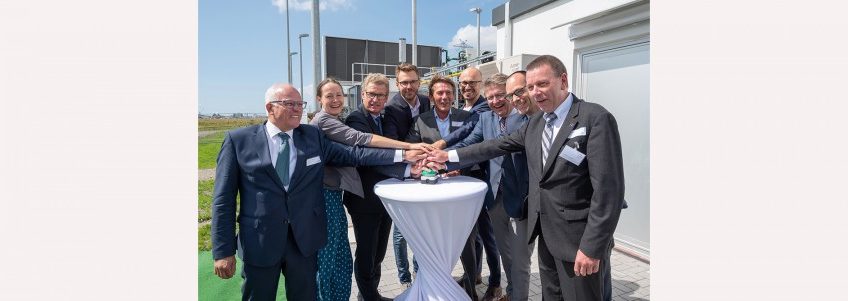The energy transition made tangible: SH Netz has spent €4.5 million on building the first plant to integrate green hydrogen into Schleswig-Holstein’s natural gas network The Wind2Gas Energy power-to-gas plant is feeding the first quantities of hydrogen into the Covestro site in Brunsbüttel. H2 MOBILITY hydrogen filling station supplies fuel-cell cars with green hydrogen
Schleswig-Holstein Netz (SH Netz) has built the first plant in Schleswig-Holstein to feed green hydrogen into the natural gas grid. The company has invested around €4.5 million in the new facility in Brunsbüttel. Wind2Gas Energy GmbH & Co KG is the operator of the electrolysis plant (power-to-gas plant) required for the generation of hydrogen, which also supplies the H2 MOBILITY hydrogen filling station with green hydrogen. Both the SH Netz feed-in facility and the Wind2Gas Energy power-to-gas plant were built on the Covestro Deutschland AG site in Brunsbüttel. The hydrogen filling station is also located on the site, but is open to the public.
“The facility to integrate hydrogen from wind energy into the gas network is a further important step towards a successful energy transition true to the slogan: from the region – for the region,” says Dr. Joachim Kabs, Chief Technology Officer of SH Netz. “These are the kind of tangible, sector-coupling measures we are taking to achieve a complete energy transition in northern Germany.”
“Feeding hydrogen into the natural gas network represents an important milestone in the energy transition here in the region,” says Tim Brandt, Managing Director of Wind2Gas Energy. “This integrated approach – production of wind power, conversion of surplus electricity into hydrogen, storage in tanks for the planned hydrogen filling station, and feeding the remaining quantity into the natural gas network – is now being tested and demonstrated at the energy and industrial location of Brunsbüttel.
“By settling the facility here, we want to give a young company in the renewable energy sector the opportunity to use the space and good infrastructure at the Covestro Industrial Park in Brunsbüttel,” says Günter Jacobsen, Covestro’s press spokesman at its Brunsbüttel site.
The funds for constructing the electrolysis plant will be provided in part by the NEW 4.0 joint project sponsored by the Federal Ministry of Economics and Energy, in which 60 partners from Schleswig-Holstein and Hamburg are jointly testing the development path to the energy system of the future. The Brunsbüttel hydrogen filling station is state-of-the-art and comes from the technology company Linde. Its operation is intuitive for drivers; refuelling is similar to that of conventional vehicles and takes three to five minutes. Hydrogen offers a way to expand the range of fuels in the transport sector in a climate-friendly way, because using hydrogen that is produced from renewable energy as in Brunsbüttel can significantly reduce climate-damaging carbon dioxide (CO2) emissions. The operation of a fuel-cell car causes no local pollutants or emissions. A full tank provides a range of 500 to 700 kilometres. Up to 80 hydrogen cars can be refilled in Brunsbüttel per day.
The filling station is funded with €1,022,667 from the Federal Ministry of Transport and Digital Infrastructure (BMVI) via the National Innovation Programme for Hydrogen and Fuel Cell Technology (NIP). The programme is coordinated by NOW GmbH (National Organisation for Hydrogen and Fuel Cell Technology).
Before the hydrogen produced in the power-to-gas plant is fed into the natural gas grid, it is tested in the measuring section to see if it meets the purity and moisture requirements. The gas volume of the hydrogen is also measured. The hydrogen is then compressed, in two compressors, to the high-pressure natural gas pipeline’s network pressure and fed into it. This redundant design guarantees the system’s requisite 96-percent availability.
The feed-in facility is completely telemonitored. All operating data is collected at the SH Netz central network control centre in Rendsburg. The system can even be accessed via a laptop by authorised personnel, using state-of-the-art IT security. “The compressor motors as well as the heat pump for heating the building that houses the facility are powered by electricity generated from renewable sources,” explains Gregor Paul, project manager at SH Netz. “We made the eco-friendliness of the operations a top priority.”
The wind power for the power-to-gas plant is supplied by the Westerbüttel wind farm, built to the north of Brunsbüttel. At peak times, the power-to-gas plant can produce up to 450 cubic metres of hydrogen per hour. This corresponds to around 40 kilogrammes per hour. A hydrogen-powered fuel-cell car can travel around 100 kilometres with one kilogramme.
Schleswig-Holstein Netz AG in brief
Schleswig-Holstein Netz AG operates electricity and gas lines in around 1,000 municipalities in Schleswig-Holstein and is responsible for the safe and reliable operation of the energy grids. As an energy transition partner, the company has connected around 36,000 renewable energy plants to its grids in recent years. With more than 380 Schleswig-Holstein municipalities as direct shareholders and the participa-tion of the eleven Schleswig-Holstein districts in the parent company HanseWerk, municipal partnership is a dominant aspect of Schleswig-Holstein Netz. The municipalities Schleswig-Holstein Netz operates in can acquire shares in the company and thereby not only make use of additional opportunities to have a say, but also participate in the economic result. The company has around 1,200 employees at various technical sites throughout the state as well as the central network control centre in Rendsburg. In total, they operate around 51,000 kilometres of high-, medium- and low-voltage networks, 13,500 kilometres of gas networks, and 7,500 kilometres of communications networks in Schleswig-Holstein.
Wind2Gas Energy GmbH & Co. KG in brief
The shareholders of Wind2Gas Energy GmbH & Co KG were among the first pioneers of wind energy use in Schleswig-Holstein. In the late 1980s, the first wind turbines were erected for self-sufficiency. The shareholders now operate numerous wind farms in the windy Dithmarschen region and thereby make a significant contribution to the energy transition. Founding Wind2Gas Energy marks the beginning of the next step towards a successful and sustainable energy transition – the market optimisation of storage technologies.
About Covestro
With revenues of €14.6 billion in 2018, Covestro is among the world’s largest polymer companies. Business activities are focused on the manufacture of high-tech polymer materials and the development of innovative solutions for products used in many areas of daily life. The main segments served are the automotive, construction, wood processing and furniture, and electrical and electronics industries. Other sectors include sports and leisure, cosmetics, health, and the chemical industry itself. Covestro has about 30 production sites around the globe and at year-end 2018 employed approximately 16,800 people (full-time equivalents).
About H2 MOBILITY
H2 Mobility Deutschland GmbH & Co. KG is responsible for establishing a hydrogen infrastructure to supply cars with fuel-cell propulsion (700 bar technology) in Germany. The interim goal by the end of 2019 is to operate 100 H2 stations in seven German metropolitan regions (Hamburg, Berlin, Rhine-Ruhr, Frankfurt, Nuremberg, Stuttgart and Munich) as well as along trunk roads and motorways. With the ramp-up of vehicle numbers, as many as 400 hydrogen stations will eventually ensure a nationwide supply. H2 MOBILITY handles all the tasks – planning, construction, operation, and marketing – that are necessary for successfully expand-ing and operating the network. The company’s shareholders are Air Liquide, Daimler, Linde, OMV, Shell and TOTAL, with BMW, Honda, Hyundai, Toyota and Volkswagen and NOW GmbH (National Organisation Hydrogen and Fuel Cell Technology) serving in an advisory ca-pacity as associated partners.
About NOW GmbH
NOW GmbH stands for holistically designed, clean, and efficient electric mobility in an integrated energy system with the key technologies of battery, hydrogen, and fuel cell. NOW puts its technical expertise to use coordinating funding programmes in the field of alternative fuels and drives, and advising the German government in these areas.
About NEW 4.0 – Norddeutsche EnergieWende
The joint project NEW 4.0 – Norddeutsche EnergiewWende is funded by the Federal Ministry of Economics and Energy as part of the “Schaufenster Intelligente Energie – Digitale Agenda für die Energiewende” funding programme. In NEW 4.0, 60 partners from business, science and politics are jointly paving the path to developing the supply of the entire region of Schles-wig-Holstein and Hamburg with 100 percent renewable electricity by 2035.


